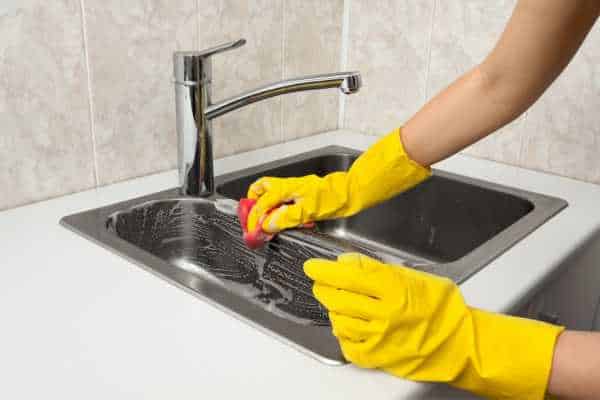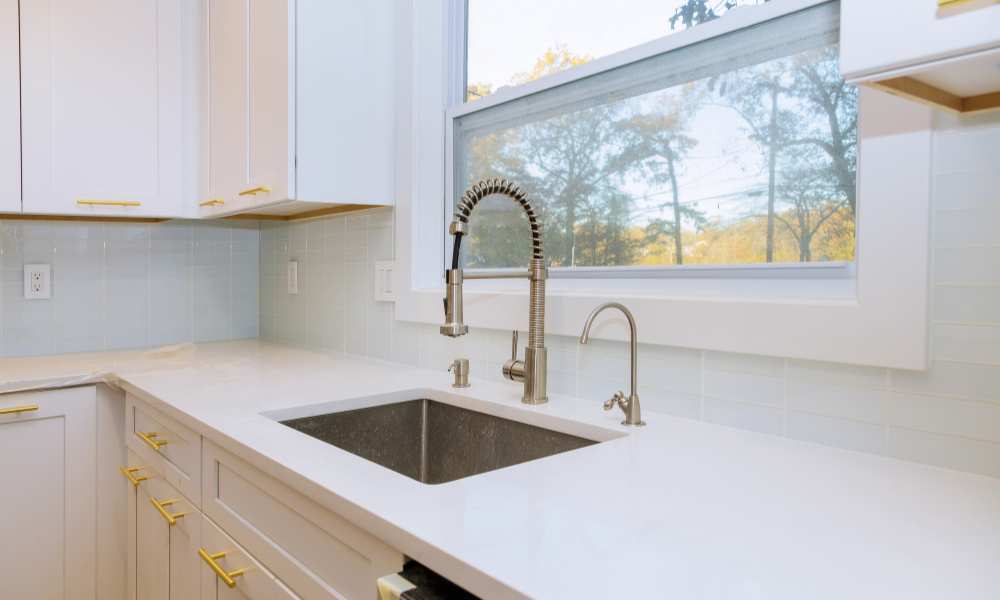Granite sinks are a stunning addition to any kitchen, but keeping them spotless and shining requires the right approach. Over time, water spots, stains, and grime can dull their natural beauty, leaving you wondering how to restore their brilliance. In this comprehensive guide, we’ll walk you through how to clean granite sink effectively using simple, safe methods that protect its surface. Whether you’re tackling stubborn stains or maintaining daily cleanliness, these expert tips will help extend the life of your sink while preserving its elegant finish. Say goodbye to harsh chemicals and hello to a sink that sparkles like new! Dive in to discover the secrets of proper granite sink care.
Essential Tools and Supplies for Cleaning a Granite Sink

Keeping a granite sink clean needs the right tools. Use a soft sponge or microfiber cloth to avoid scratches. Dish soap works for daily cleaning. Baking soda can handle stains, and white vinegar removes mineral spots. A granite cleaner keeps the surface polished and safe. Avoid using harsh chemicals or abrasive pads to prevent damage. With the right tools and supplies, maintaining your sink is simple. It stays looking great and lasts longer with proper care.
Step-by-Step Guide: How to Clean Granite Sinks Daily

Rinse the granite sink with warm water to remove debris. Use a soft sponge with mild dish soap to clean the surface gently. Avoid harsh cleaners or abrasive pads that can harm the finish. Focus on areas with buildup. After scrubbing, rinse the sink thoroughly to remove all soap. Dry it with a microfiber cloth to stop water spots from forming. To maintain shine, apply a small amount of mineral oil occasionally. This daily cleaning routine protects the granite surface and keeps the sink looking new. Regular care prevents stains and buildup, ensuring the sink stays clean and durable for years.
Removing Stains from Granite Sinks: Proven Methods
Stains on granite sinks can be removed using safe and effective methods. Start by applying a mix of warm water and mild dish soap with a soft sponge. For stubborn spots, create a baking soda paste and gently scrub the stained area. Rinse thoroughly to avoid residue. Avoid harsh chemicals or abrasive tools, as they can scratch the surface. Regularly treating your Basin with these methods ensures it stays clean and stain-free. Proper care not only restores the beauty of your granite Basin but also extends its lifespan. These simple steps make it easy to remove stains without damaging the surface or using harmful products.
How to Deep Clean a Granite Sink for Lasting Shine

Deep cleaning a granite sink is essential for maintaining its elegance and durability. Start by rinsing the Basin with warm water to remove loose debris. Mix a gentle solution of dish soap and warm water, scrubbing the surface with a soft sponge or nylon brush to avoid scratches. For stubborn stains, use a paste of baking soda and water, letting it sit before gently scrubbing. Rinse thoroughly and dry with a microfiber cloth to prevent water spots. Applying a granite-safe polish or sealer adds an extra layer of protection, ensuring your sink retains its lasting shine. Regular deep cleaning preserves the beauty and functionality of your Stone Basin effortlessly.
Do’s and Don’ts When Cleaning Granite Sinks

Granite sinks add a luxurious touch to any kitchen, but improper cleaning can lead to damage or dullness over time. Always use a soft sponge or cloth paired with mild soap to maintain the surface’s integrity. Avoid abrasive cleaners or scouring pads, as they can scratch the sink’s finish. Steer clear of harsh chemicals like bleach or ammonia, which may cause discoloration. Instead, opt for natural solutions like baking soda and water for gentle stain removal. Regularly rinse and dry the Basin to prevent water spots and mineral buildup. By following these do’s and don’ts, you’ll preserve your Stone sink’s elegance and ensure it lasts for years to come.
Natural Cleaning Solutions for Eco-Friendly Granite Care
Using natural solutions for granite sink care is safe and eco-friendly. Baking soda mixed with water works gently to remove stains and dirt. White vinegar, diluted with water, helps clean water spots without harm to the Stone. Lemon juice is also great for removing odors and keeping the Basin fresh. These simple ingredients are safe for the Basin and good for the environment. They help maintain the look of the Stone and keep it shiny for a long time. Avoid harsh chemicals and choose these natural options to protect the Stone and the environment while keeping your Basin clean and beautiful.
Dealing with Hard Water Stains on Granite Sinks

Hard water stains can quickly diminish the elegance of a granite sink, leaving unsightly marks that are challenging to remove. These stains often form due to mineral buildup from regular water use, especially in areas with hard water. To tackle these stains effectively, start by creating a gentle cleaning solution using equal parts vinegar and water. Apply the mixture to the affected areas and let it sit for a few minutes to break down the mineral deposits. Use a soft cloth or sponge to scrub the surface gently, avoiding abrasive tools that may damage the Basin. Rinse thoroughly and dry with a microfiber cloth to restore your Stone sink’s natural shine.
How to Protect and Seal Your Granite Sink
Protecting and sealing your granite sink is essential to maintain its natural beauty and durability. Over time, Stone surfaces can absorb stains, water spots, and bacteria if not properly sealed. To prevent damage, clean the Basin thoroughly and ensure it’s completely dry before applying a high-quality Stone sealer. Use a soft cloth or sponge to evenly distribute the sealer, allowing it to penetrate the surface. Once sealed, wipe away any excess to avoid streaks and let it cure for the recommended time. Regular sealing, typically every 6 to 12 months, creates a protective barrier, enhances the sink’s resistance to wear, and preserves its polished appearance for years.
Best Practices for Maintaining a Granite Sink’s Beauty
To maintain the look of a granite sink, clean it gently with non-abrasive materials daily. Avoid harsh chemicals or rough scrubbers that can harm the surface. Use mild soap or Stone -safe products for deep cleaning and rinse thoroughly. Dry the Basin after every use to stop water spots or mineral buildup. Sealing the Basin once or twice a year protects against stains and keeps it looking new. Regular care preserves its shine and durability. Following these easy tips ensures your Stone Basin stays attractive and functional over time. Proper upkeep not only enhances its beauty but also extends its lifespan effectively.
Common Mistakes to Avoid When Cleaning Granite Sinks
Using the wrong cleaning techniques can damage the natural beauty and durability of your granite Basin. Avoid abrasive cleaners or scrubbers, as these can scratch the surface and weaken the protective sealant. Harsh chemicals, like bleach or acidic solutions, may cause discoloration or dullness over time. Always dry your Basin after cleaning to prevent water spots and mineral deposits from forming. Ignoring regular maintenance can lead to stubborn stains that are harder to remove. Using improper cleaning tools, like steel wool, can leave unsightly marks. By steering clear of these common mistakes, you can maintain the elegance and longevity of your granite Basin while ensuring it remains a focal point of your kitchen.
Conclusion
Maintaining the elegance and durability of your granite sink is simple when you use the right techniques. Regular care and proper cleaning methods ensure it remains a stunning centerpiece in your kitchen for years to come. From gentle daily cleaning to tackling tough stains, following these tips will protect your sink’s finish and preserve its natural beauty. By understanding how to clean Stone Basin correctly, you avoid common mistakes that can lead to damage or discoloration. Embrace these easy-to-follow practices to keep your Basin shining and functional. With minimal effort, your granite Basin will continue to enhance your kitchen’s style and serve as a lasting investment in your home.

